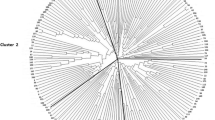Summary
A germplasm collection comprising 294 accessions of quinoa was evaluated at Cambridge, England, to assess its potential as a break crop for arable agriculture at temperate latitudes. The origins of the accessions ranged from 40°S to 2°N and from sea level to an altitude of 3800 m, and 19 discrete and continuous characteristics describing the plants' pigmentation and morphology and the duration of developmental phases were noted or measured. There was significant variation among accessions for all the continuous characteristics, and the plant and inflorescence dimensions were all fairly strongly correlated, but the associations between the durations of developmental phases were surprisingly weak, suggesting that there is great scope for manipulation of the pattern of development through breeding. Contingency tables revealed associations between pairs of discrete characteristics. The means and variances of many continuous characteristics differed according to the discrete characteristics: for example accessions with branched plants took longer to germinate and were more variable in this respect than those with unbranched plants. Sometimes one form of a discrete characteristic was associated with a homogeneous group of accessions but the alternative form was not: such a relationship would be easily lost in a multivariate analysis. On the basis of there relationships, and using knowledge of the accessions' origins, they were classified into seven groups. It is concluded that the plant characteristics required for temperate agriculture are present to a large extent in the accessions from near sea level in southern-central Chile, but that the seed characteristics are scattered throughout the germplasm.
Similar content being viewed by others
References
Aguirre, L. & M.E. Tapia, 1982. Estudio sobre quínuas de valle. In: Tercer congreso internacional sobre cultivos andinos. Instituto Boliviano de Tecnología Agropecuaria, Instituto Interamericano de Ciencias Agrícolas, La Paz, Bolivia. pp. 55–61.
Cardenas, M., 1949. Plantas alimenticias de los Andes de Bolivia. Folia Universitaria 3: 109–113. Bolivia.
Everitt, B.S., 1977. The Analysis of Contingency Tables. Chapman and Hall, London, 128pp.
Flores A., F.G., 1977. Estudio preliminar de la fenología de la quínua (Chenopodium quinoa Willd). Ingeniero Agrónomo thesis, Universidad Nacional Técnica del Altiplano, Puno, Peru.
Frankel, O.H. & A.H.D. Brown, 1984. Plant genetic resources today: a critical appraisal. In: J.H.W. Holden & J.T. Williams (Eds), Crop genetic resources: conservation and evaluation. George Allen and Unwin Ltd., London. pp. 249–257.
Frankel, O.H. & M.E. Soule, 1981. Conservation and evolution. Cambridge University Press, Cambridge, England. 327pp.
Gandarillas, H., 1967. Observaciones sobre la biología reproductiva de la quínua. Sayaña 5: 26–29.
Gandarillas, H., 1968. Razas de quínua. Boletin No. 34. Instituto Boliviano de Cultivos Andinos, División de Investigaciones Agrícolas, Ministerio de Agricultura, La Paz, Bolivia.
Gandarillas, H., 1974. Genética y origen de la quínua. Boletin No. 9. Instituto Nacional de Trigo, Ministerio de Asuntos Campesinos y Agropecuarios, La Paz, Bolivia.
Gandarillas, H., 1979. Genética y origen. In: M.E. Tapia (Ed.), Quínua y kañiwa. Cultivos andinos. Serie Libros y Materiales Educativos No. 49. Instituto Interamericano de Ciencias Agrícolas, Bogotá, Colombia. pp. 45–64.
Hauptli, H., & S. Jain, 1984. Genetic structure of landrace populations of the New World amaranths. Euphytica 33: 875–884.
I.B.P.G.R., 1981. Descriptores de quínua. International Board of Plant Genetic Resources, Rome.
Leon, J., 1964. Plantas alimenticias andinas. Boletín técnico No. 6. Instituto Interamericano de Ciencias Agrícolas-Zona Andina, Lima, Peru.
Poehlman, J.M., 1968. Breeding field crops. Henry Holt & Co., Inc, New York. 427pp.
Risi C., J., 1986. Adaptation of the Andean grain crop quinoa (Chenopodium quinoa Willd.) for cultivation in Britain. Ph.D. thesis, University of Cambridge, England. 338pp.
Risi, C., J. Galwey & N.W. Galwey, 1984. The Chenopodium grains of the Andes: Inca crops for modern agriculture. In: T.H. Coaker (Ed.), Advances in Applied Biology Vol. X. Academic Press, Inc., London, etc. pp. 145–216.
Risi C., J. & N.W. Galwey, in press. The pattern of genetic diversity in the Andean grain crop quinoa (Chenopodium quinoa Willd). II. Multivariate methods. Submitted to Euphytica.
Simmonds, N.W., 1976. Evolution of crop plants. Longman, London. 408pp.
Wilson, H.D. & C.B. HeiserJr., 1979. The origin and evolutionary relationship of huauzontle (Chenopodium nuttaliae) domesticated chenopod of Mexico. Amer. J. Bot. 66: 198–206.
Author information
Authors and Affiliations
Rights and permissions
About this article
Cite this article
Risi, J.C., Galwey, N.W. The pattern of genetic diversity in the Andean grain crop quinoa (Chenopodium quinoa Willd). I. Associations between characteristics. Euphytica 41, 147–162 (1989). https://doi.org/10.1007/BF00022424
Received:
Accepted:
Issue Date:
DOI: https://doi.org/10.1007/BF00022424




